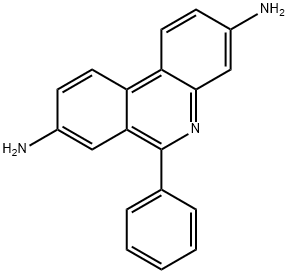3,8-DIAMINO-6-PHENYLPHENANTHRIDINE
Synonym(s):6-Phenyl-3,8-phenanthridinediamine
- CAS NO.:52009-64-0
- Empirical Formula: C19H15N3
- Molecular Weight: 285.34
- MDL number: MFCD00075152
- EINECS: 257-602-3
- SAFETY DATA SHEET (SDS)
- Update Date: 2023-04-23 13:52:06

What is 3,8-DIAMINO-6-PHENYLPHENANTHRIDINE?
Chemical properties
Crystaline Yellow Solid
The Uses of 3,8-DIAMINO-6-PHENYLPHENANTHRIDINE
3,8-Diamino-6-phenylphenanthridine is used in the synthesis of rigid polyamides. It has anti-tumor and anti-viral properties.
The Uses of 3,8-DIAMINO-6-PHENYLPHENANTHRIDINE
Used in the synthesis of rigid polyamides. It has been investigated for its anti-tumor and anti-viral properties. Small organic molecules, such as 3,8-Diamino-6-phenylphenanthridine, can bind to DNA by means of a non-specific binding along the DNA exterior.
Properties of 3,8-DIAMINO-6-PHENYLPHENANTHRIDINE
| Melting point: | 196-198 °C (lit.) |
| Boiling point: | 558.0±45.0 °C(Predicted) |
| Density | 1.292±0.06 g/cm3(Predicted) |
| storage temp. | Keep in dark place,Sealed in dry,Room Temperature |
| solubility | Soluble in chloroform, dichloromethane and methanol. |
| pka | 5.96±0.30(Predicted) |
| form | Solid |
| color | Yellow |
| CAS DataBase Reference | 52009-64-0(CAS DataBase Reference) |
Safety information for 3,8-DIAMINO-6-PHENYLPHENANTHRIDINE
| Signal word | Warning |
| Pictogram(s) |
 Exclamation Mark Irritant GHS07 |
| GHS Hazard Statements |
H302:Acute toxicity,oral H315:Skin corrosion/irritation H319:Serious eye damage/eye irritation H335:Specific target organ toxicity, single exposure;Respiratory tract irritation |
| Precautionary Statement Codes |
P261:Avoid breathing dust/fume/gas/mist/vapours/spray. P264:Wash hands thoroughly after handling. P264:Wash skin thouroughly after handling. P270:Do not eat, drink or smoke when using this product. P301+P312:IF SWALLOWED: call a POISON CENTER or doctor/physician IF you feel unwell. P302+P352:IF ON SKIN: wash with plenty of soap and water. P305+P351+P338:IF IN EYES: Rinse cautiously with water for several minutes. Remove contact lenses, if present and easy to do. Continuerinsing. |
Computed Descriptors for 3,8-DIAMINO-6-PHENYLPHENANTHRIDINE
3,8-DIAMINO-6-PHENYLPHENANTHRIDINE manufacturer
Sara R and D Center Pvt Ltd
1Y
Phone:+91-22276923680
product: 52009-64-0 / 62895-33-4 3,8-Diamino-6-phenylphenanthridine 99%
New Products
(S)-3-Aminobutanenitrile hydrochloride 4-Methylphenylacetic acid N-Boc-D-alaninol N-BOC-D/L-ALANINOL Tert-butyl bis(2-chloroethyl)carbamate 3-Morpholino-1-(4-nitrophenyl)-5,6-dihydropyridin- 2(1H)-one Furan-2,5-Dicarboxylic Acid Tropic acid 1-Bromo-3,5-Di-Tert-Butylbenzene S-2-CHLORO PROPIONIC ACID ETHYL ISOCYANOACETATE 2-Bromo-1,3-Bis(Dimethylamino)Trimethinium Hexafluorophosphate 4-IODO BENZOIC ACID 3-NITRO-2-METHYL ANILINE 1-(2,4-DICHLOROPHENYL) ETHANAMINE (2-Hydroxyphenyl)acetonitrile 4-Bromopyrazole 2-(Cyanocyclohexyl)acetic acid 4-methoxy-3,5-dinitropyridine 1-(4-(aminomethyl)benzyl)urea hydrochloride 2-aminopropyl benzoate hydrochloride diethyl 2-(2-((tertbutoxycarbonyl)amino) ethyl)malonate tert-butyl 4- (ureidomethyl)benzylcarbamate Ethyl-2-chloro((4-methoxyphenyl)hydrazono)acetateRelated products of tetrahydrofuran








You may like
-
 52009-64-0 / 62895-33-4 3,8-Diamino-6-phenylphenanthridine 99%View Details
52009-64-0 / 62895-33-4 3,8-Diamino-6-phenylphenanthridine 99%View Details
52009-64-0 / 62895-33-4 -
 3,8-Diamino-6-phenylphenanthridine CAS 52009-64-0View Details
3,8-Diamino-6-phenylphenanthridine CAS 52009-64-0View Details
52009-64-0 -
 1975-50-4 98%View Details
1975-50-4 98%View Details
1975-50-4 -
 2-HYDROXY BENZYL ALCOHOL 98%View Details
2-HYDROXY BENZYL ALCOHOL 98%View Details
90-01-7 -
 2-Chloro-1,3-Bis(Dimethylamino)Trimethinium Hexafluorophosphate 221615-75-4 98%View Details
2-Chloro-1,3-Bis(Dimethylamino)Trimethinium Hexafluorophosphate 221615-75-4 98%View Details
221615-75-4 -
 61397-56-6 CIS BROMO BENZOATE 98%View Details
61397-56-6 CIS BROMO BENZOATE 98%View Details
61397-56-6 -
 14714-50-2 (2-Hydroxyphenyl)acetonitrile 98+View Details
14714-50-2 (2-Hydroxyphenyl)acetonitrile 98+View Details
14714-50-2 -
 118753-70-1 98+View Details
118753-70-1 98+View Details
118753-70-1
Statement: All products displayed on this website are only used for non medical purposes such as industrial applications or scientific research, and cannot be used for clinical diagnosis or treatment of humans or animals. They are not medicinal or edible.